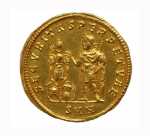AD 310
Creation of the solidus by Constantine
After the economic disruption caused by the inflationary crisis of the 3rd century AD, Emperor Constantine decided to reform the monetary system in order to restore stability. In AD 310, he began to issue a new gold coin called the solidus, whose name, derived from the Latin for solid, clearly reflected the emperor’s desire to stabilise the currency. In AD 312, the weight of the solidus was set at 4.55g, representing a devaluation of around 15% compared to the Diocletian aurelus. It continued to be used throughout the Byzantine Empire up until the 10th century, and its weight remained unchanged. Constantine ensured there was a sufficient supply of gold to issue the solidus through the seizure of war booty from his enemy Licinius, the confiscation of gold from pagan temples and the application of new taxes that were payable in gold. The solidus was the cornerstone of the new Roman monetary system throughout the 4th and 5th centuries.


